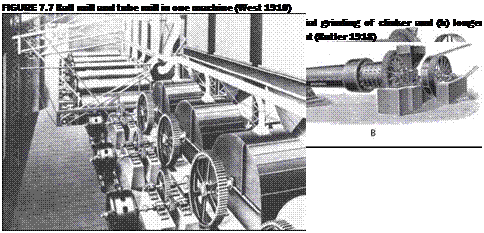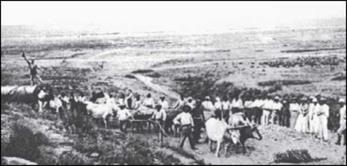By 1890, 100 Krupp-Grusonwerk tumbling mills were operating in cement plants, and other companies were manufacturing them. One company that contributed much to the technology of tumbling mills was F. L. Smidth and Co. of Denmark. This company had been established as a one-man consulting engineering business by Frederik Laessoe
|
|
Smidth in 1882 and had grown rapidly through contracts to build cement plants. In 1893, the firm acquired the rights to a tube mill from a French inventor and sold it worldwide after redesigning it. The problem was that mills were so large and heavy that it was often difficult to transport them to plant sites. One solution is shown in Figure 7.5.
One approach to grinding clinker involved using a short tumbling mill, called a ball mill, to break the fresh clinker to the size of grit or sand and a long tumbling mill, which was called a tube mill, to grind the grit to cement. Both mills used trunnions to discharge the ground products. Short ball mills and tube mills made by Krupp are shown in Figure 7.6.
The success of tube mills led to finished cement being produced in shorter tube mills operating in closed circuit with air separators or in longer tube mills operating in open circuit. The details of one mill-separator circuit were
■ The mill was 1.6 m in diameter and 3.6 m long, and the separator was 2.8 m in diameter.
■ The rotary kiln clinker was fed to the circuit in pieces up to the size of hazelnuts at a rate of 4.5 tph.
■ The circulating load was 150%-200% and the finished cement contained 16% +90 pm particles.
■ The power consumed by the mill, separator, and elevator was 82 kW (110 hp; West 1910)
Next the short mill and the tube mill were combined into one machine, shown in Figure 7.7, and mills of this type were made in Germany. It can be regarded as the original two-compartment mill.
The material to be ground is fed into the hollow trunnion in the ordinary way, and in the first part of the mill is acted upon by a number of steel balls of varying sizes, by which it is reduced to a grit by the time it reaches the division between the two portions of the mill. Here it falls on to a steel plate provided with suitable apertures, which only allows the sufficiently reduced material to pass, the residue being returned to the ball mill part for further reduction. The material which passes the openings in the steel plate is carried forward into the ball mill portion for further reduction. (Butler 1913)
The Gates Iron Works of Chicago was a leading manufacturer of machinery for the mining and cement industries. Figure 7.8 is a photograph from a cement plant of the early
 |
1900s showing Gates peripheral discharge mills in the foreground and tube mills for fine grinding in the background. The peripheral discharge mills were similar to the mills with peripheral screens developed by Krupp in Germany. By the early 1900s, Krupp mills were trunnion discharge mills. A mill in a cement plant in 1906 is pictured in Figure 7.9.

